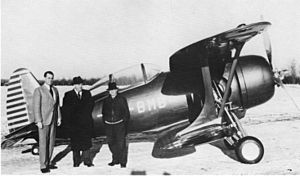Gregor FDB-1
| Gregor FDB-1 | |
|---|---|
 |
|
| L-R: George Ayde, Can-Car representative David Boyd and designer Michael Gregor | |
| Role | Fighter |
| Manufacturer | Canadian Car and Foundry |
| Designer | Michael Gregor |
| First flight | 17 December 1938 |
| Introduction | Experimental |
| Status | Destroyed 1945 |
| Produced | 1938 |
| Number built | 1 |
The Gregor FDB-1 was a Canadian biplane fighter, designed in 1938 by Michael Gregor and manufactured by Canadian Car and Foundry. Despite being an advanced and innovative design, incorporating all-metal construction with flush riveting, retractable undercarriage and a sleek shape, the FDB-I was overtaken by events and, after being unable to find a buyer, was lost in a fire in 1945.
In 1938, American and Russian expatriate designer Michael Gregor approached Canadian Car & Foundry, at the time, that country's leading manufacturer of rolling stock, which had limited experience building airplanes, but wanted to enter that field. Instead of building its own designs, Can-Car was producing Curtiss, de Havilland, Consolidated, Bristol and Hawker products under license. In 1936, Grumman and Canadian Car & Foundry or "Can-Car" concluded an agreement for production of 50 revised Grumman SF-1 carrier fighters, with 700 hp. Wright R-1820-78 radial power-plants and known as GE-23s or Grumman Exports 23s, that would be put together in Canada (although some were actually assembled in Spain).
In 1938, there were many aviation observers who doubted the supposed merits of the emerging monoplane over the proven performance of reliable biplanes. Most of the major powers' front line fighter units employed biplanes. The Soviet Union, despite having recently developed the Polikarpov I-16 (the first successful production monoplane fighter with retracting gear), still depended heavily on biplanes. Great Britain's RAF and Nazi Germany's Luftwaffe had likewise embraced the monoplane but, respectively, continued to deploy the Gloster Gladiator and the Heinkel He 51 biplane fighters. In Fascist Italy, the series of Fiat CR.32 in operation and the Fiat CR.42 biplane fighters were entering service while the U.S. Navy operated biplane fighters exclusively.
...
Wikipedia
